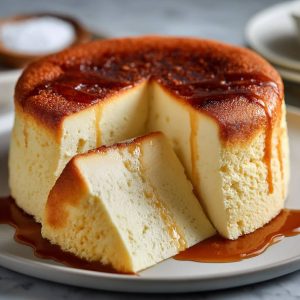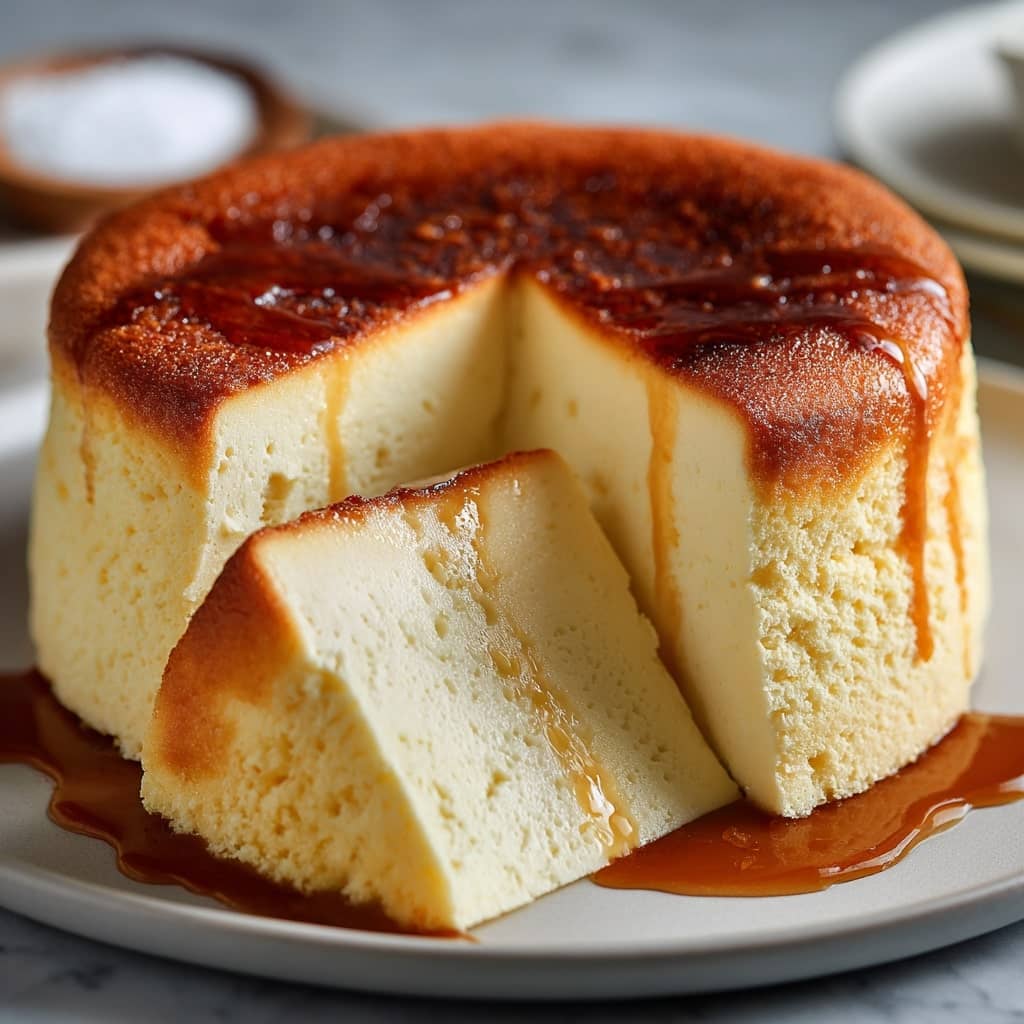Japanese Cheesecake, also known as “Japanese Cotton Cheesecake” or “Soufflé Cheesecake,” is a uniquely light and airy dessert that combines the rich flavors of cream cheese with the delicate texture of a soufflé. Unlike the dense, heavy Western-style cheesecakes, this cake is fluffy, moist, and almost cloud-like, often described as a perfect balance between a traditional cheesecake and a sponge cake. Its gentle sweetness and melt-in-the-mouth softness have made it an internationally beloved treat, celebrated not only for its flavor but also for its elegant, simple presentation.
The History of Japanese Cheesecake
The origins of Japanese Cheesecake trace back to the 1960s when it was introduced as a reinterpretation of classic European cheesecakes, adapted to Japanese taste preferences which favor lighter textures and less sweetness. The cake gained popularity in Japan’s cafes and bakeries, quickly becoming a staple dessert. Influenced by French techniques of making soufflés and Western cheesecake recipes, the Japanese version emphasizes whipped egg whites folded into a cream cheese batter, producing its signature airy structure. Over time, it spread globally as people discovered the joy of its subtle flavors and satisfying texture, making it a modern classic in the world of desserts.
Ingredients Breakdown
- Cream cheese: The primary flavor component, providing richness and tang.
- Eggs: Separated into yolks and whites; yolks enrich the batter, while whipped whites create the airy texture.
- Sugar: Sweetens the cake but is used moderately to keep the delicate balance.
- Milk: Adds moisture and helps achieve a smooth batter.
- Butter: Adds richness and helps tenderize the crumb.
- Cake flour or all-purpose flour: Provides structure without making the cake heavy.
- Lemon juice or zest (optional): Adds a hint of brightness and balances the richness.
- Cornstarch (sometimes included): Stabilizes the batter and adds a slight tenderness.
Step-by-Step Recipe
- Preheat your oven to 320°F (160°C). Prepare a round cake pan by greasing it and lining the bottom with parchment paper. Wrap the outside of the pan with aluminum foil to prevent water from leaking during the water bath.
- In a large bowl, beat the cream cheese until smooth. Add in softened butter, milk, and lemon juice (if using), mixing until combined and creamy.
- Separate the eggs. Add the egg yolks one at a time into the cream cheese mixture, beating well after each addition.
- Sift the flour and cornstarch together and gradually fold them into the batter until smooth and well incorporated.
- In a separate clean bowl, whip the egg whites with a pinch of salt until foamy, then gradually add sugar while continuing to whip until stiff peaks form.
- Gently fold one-third of the whipped egg whites into the cream cheese batter to lighten it. Then fold in the remaining whites carefully to maintain the airy texture.
- Pour the batter into the prepared pan and place it in a larger baking dish filled with hot water, creating a water bath (bain-marie).
- Bake for 60-70 minutes or until the cake is lightly browned and a skewer inserted in the center comes out clean.
- Turn off the oven and leave the cake inside with the door slightly ajar for 15 minutes to prevent cracking. Remove from the oven and cool completely before refrigerating.
Tips for the Perfect Japanese Cheesecake
Use room temperature ingredients to ensure smooth mixing and incorporation. Be gentle when folding the egg whites to retain the fluffiness of the batter. Avoid opening the oven door frequently during baking to maintain a stable temperature and avoid collapsing. The water bath is essential to provide even heat and moisture, preventing cracks and dryness. Use a non-stick or well-prepared pan for easy release. Cooling the cake gradually helps preserve its delicate texture and prevents shrinkage or cracks. Sifting the flour and cornstarch ensures a lump-free batter and a tender crumb.
Variations and Customizations
Add flavors like matcha (green tea powder) or yuzu zest for a citrusy twist popular in Japan. Incorporate fresh fruit toppings such as strawberries or blueberries for added freshness and color. Dust the top with powdered sugar or cocoa powder for a simple decorative finish. Use cream cheese substitutes like mascarpone for a richer flavor or reduced-fat cream cheese for a lighter option. Try different extracts such as vanilla or almond to change the flavor profile subtly. For a gluten-free version, substitute the flour with gluten-free flour blends ensuring similar texture.
Health Considerations and Nutritional Value
Japanese Cheesecake is lighter and lower in fat compared to traditional cheesecakes, mainly due to the incorporation of whipped egg whites and reduced sugar. However, it still contains dairy and eggs, which should be consumed in moderation for those monitoring cholesterol or lactose intolerance. The cake provides protein from eggs and cream cheese, calcium from dairy, and moderate carbohydrates from sugar and flour. Its relatively lower sugar content compared to Western desserts makes it a more balanced treat, but portion control is recommended for calorie-conscious individuals. For healthier variations, sugar substitutes or lower-fat dairy options can be used, but these may affect texture and flavor.
FAQ
Q: Can I make Japanese Cheesecake without a water bath?
A: The water bath is highly recommended to maintain moisture and prevent cracking, but you can bake without it—expect a denser and possibly cracked cake.
Q: Why does my cheesecake sink in the middle?
A: Overmixing, opening the oven door too early, or not cooling gradually can cause sinking. Gentle folding and proper baking are key.
Q: Can I freeze Japanese Cheesecake?
A: Yes, wrap it tightly and freeze for up to one month. Thaw in the refrigerator before serving.
Q: Can I substitute cream cheese?
A: Mascarpone or a blend of cream cheese and ricotta can be used for different textures and flavors.
Q: How long does it keep?
A: Store refrigerated for up to 4-5 days in an airtight container.

Japanese Cheesecake
Ingredients
For the cheesecake:
- ▢ 6 large eggs separated (each approximately 50g with shell)
- ▢ 8 ounces cream cheese preferably softened
- ▢ ¼ cup heavy cream or whole milk
- ▢ 4 tablespoons unsalted butter cut into small pieces
- ▢ ½ cup cake flour fluffed, spooned, and leveled
- ▢ 1 tablespoon lemon zest about one lemon, optional
- ▢ 1½ teaspoons vanilla extract optional
- ▢ ⅓ cup granulated sugar
- ▢ 2 teaspoons lemon juice about one-third of a lemon
Optional toppings:
- ▢ Powdered sugar for dusting
- ▢ Apricot jam for glazing gently warmed
▢ Fresh berries
- ▢ Sweetened whipped cream
Instructions
- Prepare the equipment: Preheat your oven to 300°F. Line the bottom of an 8-inch by 3-inch cake pan with a circle of parchment paper and prepare a 9-inch by 9-inch baking pan. The 9×9 inch pan will be used for a water bath, so any larger pan that can hold the 8-inch round cake pan will work as well. Bring several inches of water to a simmer in a large saucepan or pot. Once simmering, reduce the heat to low. Make the base batter: Place the cream cheese, butter, and cream in a large heatproof bowl that can sit over the saucepan without touching the water. Warm the mixture slowly, whisking until smooth and fully combined. Turn off the heat. Add the egg yolks and mix well. Immediately sift the cake flour into the bowl and whisk until no lumps or dry flour remain. Remove the bowl from the heat and stir in the lemon zest and vanilla extract. Whisk to combine and set aside to cool. Work quickly to avoid scrambling the egg yolks! Fill the 9×9 baking pan halfway with hot water and carefully place it in the oven to preheat (or use the hot water you already have). Prepare the meringue: In a clean bowl, combine the egg whites and lemon juice. Using a hand mixer, whip the egg whites on medium-high speed until frothy. Gradually add the granulated sugar, about one-third at a time, before the whites reach the soft peak stage. Once all the sugar is incorporated, continue whipping for 10 to 20 seconds more. Then lower the speed to medium and whip until medium-soft peaks form. Refer to photo guides if needed. Gently fold one-third of the meringue into the cream cheese mixture until no streaks remain. Fold in the remaining meringue in two additions. Pour the batter into the prepared 8-inch cake pan and firmly tap it on the counter a few times to release large air bubbles. A skewer can also be used to pop any remaining bubbles. Bake the cheesecake: Carefully place the cake pan into the water bath inside the oven. Bake for approximately 80 to 90 minutes, until the cheesecake is golden brown on top and a skewer inserted in the center comes out clean. Remove the cheesecake from the oven and dry the bottom of the pan. Let it cool for a few minutes on its side, rotating the pan every 20 to 30 seconds, until the cheesecake loosens from the sides. Remove the cheesecake from the pan by flipping it onto a plate. Peel off the parchment paper and flip the cake upright onto another plate. Let it cool completely. Serve: The Japanese cheesecake can be enjoyed warm, fully cooled, or chilled in the refrigerator for at least one hour. Keep it plain, dust with powdered sugar, or glaze with apricot jam. Serve alone or with fresh fruits, berries, and whipped cream.

